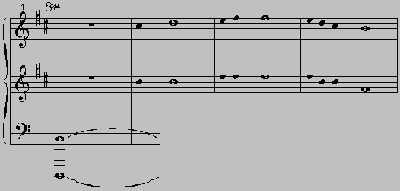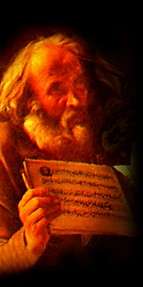 |
 |
 |
 |
 |
|
| COMPOSITIONAL VOICE |  |
|
The first composition in pärt's new style was the piano piece Für Alina. It is a composition of widely spaced pitches, open intervals and pedal tones.

Arvo pärt Für Alina © 1990 by Universal Edition A.G., Wien. All Rights Reserved. Used by permission of European American Music Distributors Corporation, sole U.S. and Canadian agent for Universal Edition, A.G., Wien.
These characteristics, among others, have become the quintessential elements in pärt's post-1976 compositions. This piece is also the first to be composed using the tintinnabulation technique. pärt states, "That was the first piece that was on a new plateau. It was here that I discovered the triad series, which I made my simple, little guiding rule." 5 pärt refers to this new style as "tintinnabuli." 6 This can be defined as the application of various inversions of a certain chord. Also, it is a word "which evokes the pealing of bells, the bells' complex but rich sonorous mass of overtones, the gradual unfolding of patterns implicit in the sound itself, and the idea of a sound that is simultaneously static and in flux." 7 pärt explains the term this way:
Tintinnabulation is an area I sometimes wander into when I am searching for answers - in my life, my music, my work. In my dark hours, I have the certain feeling that everything outside this one thing has no meaning. The complex and many-faceted only confuses me, and I must search for unity. What is it, this one thing, and how do I find myway to it? Traces of this perfect thing appear in many guises - and everything that is unimportant falls away. Tintinnabulation is like this. . . . The three notes of a triad are like bells. And that is why I call it tintinnabulation. 8
More specifically, the tintinnabulation involves the predominance of a single triad in one or more voices. In a four-voice context, it is likely that two of the voices will sound only notes of a single triad. This triad is, in most cases, the tonal center of the piece from which pärt rarely dePärts.
When comparing all of pärt's post-1976 works, there is one underlying theme: the numinous. Arvo pärt's approach to religion has given rise to a humbleness in his artistic aims – his is an attempt to fathom what is secret and unknowable, and he is aware that this will be revealed to him in untranslatable musical forms, if at all – in works which silence chooses to abandon of its own accord. 9 His music is often said to transport the listener to a "moment outside time" 10, emerging from silence at the beginning of the work and slowly returning to it as the piece closes. Whatever the intention of the piece, many of his works can be said to reflect the inconceivable sadness that Mary and the disciples felt as Christ was crucified before them on the cross. Sandner states, "In a world in which Christian ideals are not universally acknowledged, this state of suffering (of the Passion of Christ without which all that comes after Christ cannot occur) is not one that must be artificially created." 11 The melodic figures, restricted to only a few notes, are powerful in that they are filled with both grace and sadness. Sandner notes that, "Arvo pärt's cryptic remarks on his compositions orbit around the words 'silent' and 'beautiful' – minimal, by now almost imperiled associative notions, but ones which reverberate his musical creations." 12 Unresolved dissonance is exploited, most notably at phrase beginnings and endings and on decidedly important syllables of text. However, each dissonance means in ways that cannot be easily described. That is to say that the dissonances are used, not as flamboyant exhibitionist gestures (as in his earlier serial works), but as unassuming vehicles for conveying an enigmatic sorrow.
Remarkably, many of the most powerful moments in pärt's compositions are a result of the action of a single line or the counterpoint created by only two voices. Examples of this can be heard in the Magnificat, the Passio Domini Nostri Jesu Christi Secundum Joannem, and the Stabat Mater, among others. pärt states: "I have discovered that it is enough when a single note is beautifully played. This one note, or a silent beat, or a moment of silence, comforts me. I work with very few elements - with one voice, with two voices. I build with the most primitive materials - with the triad, with one specific tonality." 13 pärt rarely dePärts from this one specific tonality; his later works exhibit an almost total lack of chromaticism.
A compositional style that was previously characterized by violent dissonance has now been reborn. Free and random dissonance is no longer tolerated. His goals are now closely aligned with those of the middle ages in that, "The spirit of the music was objective. Composers strove for a cool balance of musical elements within a strong formal framework, an ideal evident in all the essential characteristics of the music…a playing down of purely sensuous appeal." 14 Dissonance in this new style is created through diatonic means, either through close interplay between two or three voices or with the use of carefully constructed pandiatonic tone clusters. The intent is not to be abrasive but rather to convey the sense of suffering that is so apparent in many of pärt's works. "It has a beauty at once austere and sensuous that seems to be hardly of our time. Yet there can be little doubt that the revelation of his music has been one of the most important factors in the development of a new sensibility in recent music" 15
©1996 David E. Pinkerton II
|
6 Ingram Marshall, liner notes for Annum per Annum, Christoph Maria Moosmann, organ, (New Albion NA074CD).
7 Morton and Collins, eds., Contemporary Composers, 729.
8Richard E. Rodda, liner notes for Arvo Pärt Fratres, I Fiamminghi, The Orchestra of Flanders, Rudolf Werthen, (Telarc CD-80387).
9 Sandner, liner notes for Arvo Pärt Tabula Rasa.
10 Mellers, liner notes for Arvo Pärt Arbos.
11 Sandner, liner notes for Arvo Pärt Tabula Rasa.
12 Sandner, liner notes for Arvo Pärt Tabula Rasa.
13 Richard E. Rodda, liner notes for Arvo Pärt Fratres.
14 Donald J. Grout and Claude V. Palisca, A History of Western Music, 4th ed., (New York and London: W.W. Norton and Company, 1988), 133.
15 Morton and Collins, eds., Contemporary Composers, 729.
|
|
|
|

